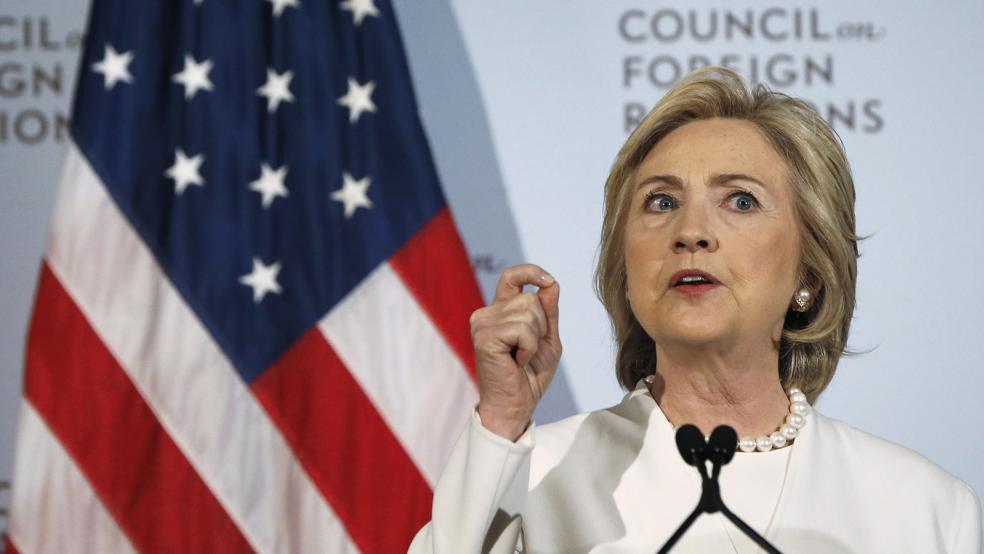While Republican Donald Trump and others in the presidential sweepstakes went big and bold with their tax and spending plans this year, Democratic presidential frontrunner Hillary Rodham Clinton opted for a more cautious and pragmatic fiscal path.
The former secretary of state ruled out huge tax cuts for the rich and the business community like those billionaire businessman Trump initially proposed, as well as the massive tax hikes that Sen. Bernie Sanders of Vermont advocated to underwrite the cost of his social revolution. But exactly what does her plan do, and how will it affect businesses, the economy and the average taxpayer?
The Fiscal Times convened a panel of experts in tax and fiscal policy to analyze the Clinton and Trump tax plans. Details of each plan were reviewed by three well-respected policy experts: William G. Gale, the Arjay and Francis Miller Chair in Federal Economic Policy at the Brookings Institution and co-director of the Tax Policy Center; Doug Holtz-Eakin, President of the American Action Forum and a former Congressional Budget Office Director; and G. William Hoagland, a vice president of the Bipartisan Policy Center and a former Republican Senate budget official.
Related: How Obamacare Could Backfire on Hillary Clinton
The Trump and Clinton tax plans were graded by each expert on four variables: legislative feasibility, potential for economic growth, impact on taxpayers and fiscal responsibility. The results of the analysis for Clinton are in the report card below (click here for the analysis of Trump’s tax plan).
| Gale | Hoagland | Holtz-Eakin | Average | |
| Legislative feasibility. | B | C | D | C |
| Economic growth | B | D | F | D+ |
| Fiscal responsibility | A | B | D | B- |
| Impact on taxpayers | A | B | D | B- |
| Expert Average | A- | C+ | D- |
Looking at economic growth, Gale said that the Clinton plan “will probably be close to a wash in terms of economic growth over the medium term.”
Gale also said that the increase in tax rates might hurt growth in the short-term. But he said that a reduction in debt under the plan “should help growth in the long-term.” However, the Tax Policy Center analysis of Clinton’s plan used by Gale doesn’t address Clinton’s long-term spending proposals and the effect they might have in raising the long-term debt.
Holtz-Eakin, a conservative economist, is highly dismissive of Clinton’s proposal and says it would add to the country’s long-term fiscal problems. “These tax increases are immediately spent, leaving the basic unsustainability of the budget untouched,” said Holtz-Eakin.
Related: Clinton’s Tax Hikes on the Rich Could Raise $1.1 Trillion Over 10 Years
Hoagland also raised some concerns. He said he was especially concerned about Clinton’s proposals to raise the holding period for long-term capital gains and impose a transaction tax on high frequency traders. He warned that both ideas might have some dampening impact on investments and growth.
“Further [the failure to] lower the corporate tax rate to be competitive in a global market is a major shortcoming of the plan,” Hoagland said.
Clinton’s Plan
Clinton and her advisers forged a three-pronged plan that reflected her campaign themes while preserving the basic framework of the individual and corporate tax laws.
First, she embraced the “Buffett rule” – the argument that the wealthiest Americans should have to pay at minimum a higher effective tax rate. Second, Clinton wanted to signal to Sanders and her other sharp critics in the liberal wing that – despite her reputation for coziness with Wall Street and acceptance of large speaking fees from Goldman Sachs – she wasn’t reluctant to slap big banks, hedge fund operators and other wealthy investors with higher taxes and fees.
Third, she underwrote most of the cost of her social and economic agenda by raising taxes on the wealthiest Americans, without driving up the debt too much or rocking the economy. Clinton was something of a piker compared to Sanders in promoting her agenda. Even so, her long term programs include new infrastructure construction, paid family leave, early childhood education, college tuition relief and expanded health care coverage, just to name a few.
Related: Trump’s Tax Cuts Would Add $24.5 Trillion to the Debt
According to a Committee for a Responsible Federal Budget analysis, Clinton’s social and economic programs would cost $1.8 trillion over the coming decade. She devised a strategy to offset $1.6 trillion of the total cost, including $1.3 trillion of new tax revenue. The remainder of the overall cost would be added to the debt.
David Kamin, a senior Clinton economic adviser, says that Clinton intended to signal to voters that “we have a real problem in the country when it comes to making sure that some of the very richest Americans or corporations play by the rules.”
“It’s reflecting the fact that, right now, there are too many opportunities for sophisticated taxpayers to try to avoid paying the taxes that they should be – both at the individual level and the corporate level,” he said in an interview. Kamin added that especially on the corporate side, there is far too much “gaming” including mergers with overseas companies to avoid U.S. taxation levels.
To make good on her commitment to the “Buffett rule,” Clinton proposed a new 30 percent minimum effective tax rate on adjusted gross income (AGI) above $1 million. She also proposed a 4 percent surcharge on AGI above $5 million, to create a new marginal income tax rate of 43.6 percent.
Related: Sanders’s ‘Great Society’ Plan Could Add $15 Trillion to the Debt
Her plan would impose a 28 percent limit on the tax value of deductions, income exclusions and other loopholes that are highly popular with wealthier families and individuals.
Her plan would permanently lowering the tax threshold for estates from $5.4 million to $3.5 million for individuals and from $10.9 million to $7 million for married couples. Estate taxes have historically been very controversial, especially among farmers and small business owners. Her plan would raise the top estate tax rate to 45 percent and set the lifetime tax exemption at $1 million. And it would limit tax-preferred contributions to retirement accounts with large balances.
Taken together, those measures accounted for about a quarter of overall new tax revenue and would at least slightly help narrow the huge income gap between the very rich and everybody else in the country.
She was equally aggressive in taking aim at Wall Street and the investment class.
Related: Clinton Moves Towards Sanders on ‘Medicare for All’
The Clinton plan would eliminate the “carried interest” provisions that has allowed hedge funds and private equity accounts to pay a tax rate on their profits far below the rate that most Americans pay on ordinary income. She proposed another controversial change in the capital gains tax law to punish investors who don’t hold onto their assets for six years or longer rather than looking for quick profits.
Large banks and financial institutions that once were deemed “too big to fail” would be hit with substantial “risk fees” on a sliding scale if they grow too big in size and accumulate riskier, short-term debt.
Clinton would also impose a “high frequency tax” on algorithmic traders who often place and cancel millions of orders a year.
Clinton also would cancel a tax credit on fossil fuel production to remove any incentive to produce cheaper oil or gas that can cause global warming. And for corporations seeking to shelter their profits overseas, Clinton would increase the threshold for foreign ownership in an inversion transaction, before a U.S. company can give up its U.S. tax residence.
Related: Experts Warn Trump and Clinton of a Big Threat to the Economy
Taken together, Clinton’s tax proposals make some important changes around the edges of the federal tax code but she shies away from any fundamental restructuring of the federal tax system.
With the exception of the new top marginal tax rate of 43.6 percent for high rollers, the federal income and corporate tax brackets remain unscathed. Nearly all of the tax increases would fall on the top 1 percent of taxpayers, while the bottom 95 percent of taxpayers would see little or no change in their taxes, according to the Urban-Brookings Tax Center.
Clinton’s plan would do nothing to slow the long term growth of the national debt, although budget analysts give her credit for attempting to offset much of the cost of her spending plans. As for its impact on the economy, experts say the new, higher marginal tax rate would reduce incentives to work, save and invest.
| Hillary Clinton - Tax Plan Highlights |
| Individual Income Taxes |
| Adds a 4% surcharge to taxable income over $5 million. |
| Enacts the Buffett Rule, a 30% minimum tax on Adjusted Gross Income over $1 million. |
| Caps the tax value of all itemized deductions at 28%. |
| Raises rates on medium and long-term capital gains to between 27.8 and 47.4 %. Gains on assets held less than two years would be taxed as ordinary income. |
| Limits the total value of tax-deferred and tax-free retirement accounts. |
| Taxes carried interest as ordinary income. |
| Provides tax credits for caregiving expenses for elderly family members and high out-of-pocket health care expenses. |
| Estate and Gift Taxes |
| Reduces estate tax threshold from $5 million back to $3.5 million ($7 million for married couples) with no adjustment for future inflation. |
| Increases the top tax rate to 45% and sets the lifetime gift tax exemption at $1 million. |
| Business Taxes |
| Increase the threshold for foreign ownership in inversion transactions from 20% to 50% of the combined company shares. |
| Imposes an “exit tax” on unrepatriated corporate earnings. |
| Limits interest deductions for U.S. affiliates of multinational companies. |
| Assesses a “risk fee” on large financial institutions. |
| Enacts a tax on high-frequency trading, at an unspecified rate. |
| Provides tax credits for investments in community development and infrastructure and for hiring apprentices or profit-sharing. |
| Proposes reform of performance-based tax deductions for highly paid executives of public companies. |
| Eliminates tax incentives for fossil fuels. |
| Reauthorizes and expands Build America Bonds. |
| Source: Tax Foundation and Tax Policy Center |







